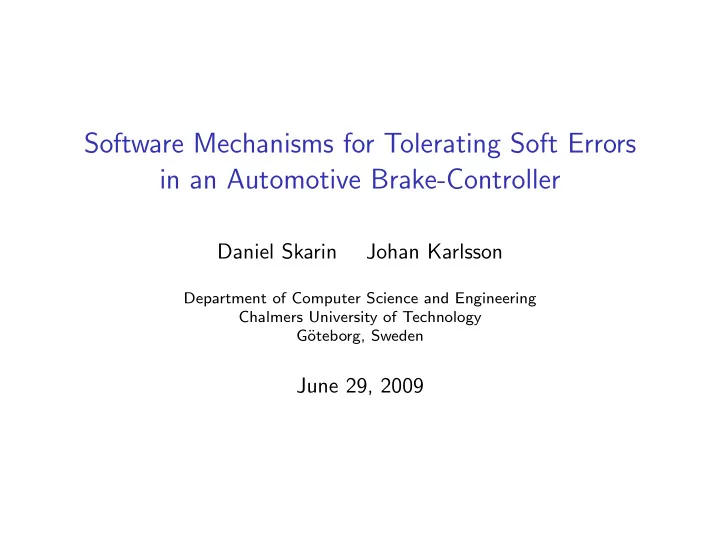

Software Mechanisms for Tolerating Soft Errors in an Automotive Brake-Controller Daniel Skarin Johan Karlsson Department of Computer Science and Engineering Chalmers University of Technology G¨ oteborg, Sweden June 29, 2009
Introduction ◮ Soft errors are becoming an increasingly important source of computer failures, also in embedded systems. ◮ The dominant cause of soft errors are terrestrial cosmic rays. ◮ Circuit- and architectural level mechanisms in microprocessors may not provide perfect error coverage. ⇒ Soft errors can reach the architected state. ◮ Goal: Investigate the possibility of building a brake controller program, which is fail-bounded with respect to soft errors.
Fail-bounded control systems ◮ Control systems can produce incorrect outputs and still provide acceptable performance. ◮ A fail-bounded system is allowed to produce incorrect outputs, which have a benign effect on the controlled object. ◮ Error detection mechanisms must enforce an upper bound on the difference between an incorrect output and the corresponding fault-free output. ◮ The concept of fail-bounded systems was introduced by Silva et al. in 1998.
Example brake-by-wire system Wheel ECU Wheel ECU Pedal Wheel ECU ECU Wheel ECU
Research questions General question ◮ Can we make a non-redundant control ECU fail-bounded with respect to soft errors? Question addressed by this work ◮ Can we make a non-redundant control ECU fail-bounded with respect to single bit-flip errors in ISA registers and the data segment of the main memory?
Contributions Extensive evaluation of two simple software mechanisms aimed at achieving a fail-bounded brake controller. ◮ The error coverage of the mechanisms have been determined for single bit-flips in ISA registers and the data segment of the main memory. ◮ Exhaustive evaluation for three control loops: All possible single bit-flips injected. ◮ All ISA registers including the program counter tested.
Limitations of the single bit-flip fault model ◮ We emulate soft errors in the architected state as single bit-flip errors in registers and memory. ◮ Single bit-flips are injected via the debug port of the target microcontroller. Uncertainties ◮ Soft errors may not manifest themselves as single bit-flips. ◮ Out-of-specification behaviors of the processor are not considered.
Prototype brake controller ◮ Actuator commands are produced by a PI-controller ◮ We distinguish between benign failures and critical failures . Brake actuator command Brake actuator command 1 1 Incorrect output Incorrect output 0.8 0.8 Fault-free output Fault-free output 0.6 0.6 0.4 0.4 0.2 0.2 Wheel speed Wheel speed 0 30 30 0 -0.2 -0.2 25 25 -0.4 -0.4 -0.6 20 20 -0.6 -0.8 Speed [m/s] Speed [m/s] -0.8 -1 15 15 0 0.5 1 1.5 2 2.5 3 3.5 0 0.5 1 1.5 2 2.5 3 3.5 Time [s] 10 10 5 5 0 0 0 0.5 1 1.5 2 2.5 3 3.5 0 0.5 1 1.5 2 2.5 3 3.5 Time [s] Time [s]
Low-cost error detection and recovery Software mechanisms ◮ Error detection: ◮ Run-time check for invalid transitions of the controller’s integral state. ◮ Stack pointer protected by duplication and comparison check. ◮ Error recovery: ◮ Rollback to previous controller state ◮ Soft reset Hardware exceptions for error detection ◮ Machine check exception, Alignment exception, Floating point assist exception, . . .
Experimental evaluation We evaluated two versions of the brake controller: ◮ Basic version – Hardware exceptions for error detection. ◮ Robust version – Hardware exceptions and software implemented error detection and recovery. Extensive fault injection experiments conducted for each version. ◮ For three control loops, we injected all possible single bit-flips in “live” ISA registers and the data segment of the memory. ◮ About 30 000 errors were injected for each program version and control loop iteration.
Important observations ◮ Our software mechanisms combined with hardware exceptions reduced the proportion of critical failures significantly. ◮ Only 0.04% of the injected errors resulted in critical failures, compared to 1.2% for the basic version. ◮ A dominant cause of critical failures was control-flow errors. ◮ In total, about 56% of the injected errors caused incorrect outputs in the robust version. ◮ These errors had no significant impact on the brake performance.
Conclusions ◮ Our results show that simple mechanisms for error detection and recovery can effectively enforce fail-bounded semantics for the brake controller with respect to single bit errors. ◮ Open issues ◮ How valid is the single bit-flip assumption? ◮ How do we model multiple bit-flips? ◮ What is the impact of out-of-specification behaviors of the microprocessor?
Fault injection data available on-line http://www.amber-project.eu
Recommend
More recommend